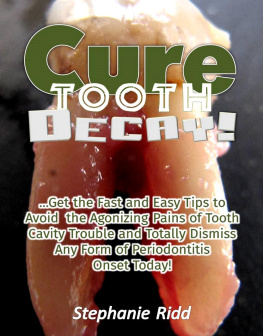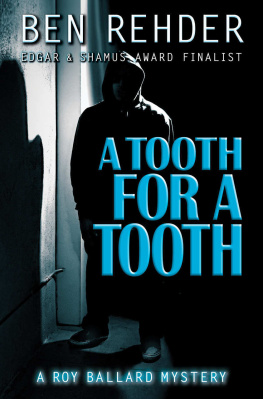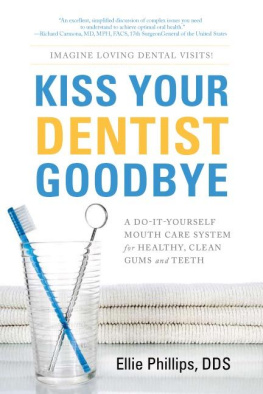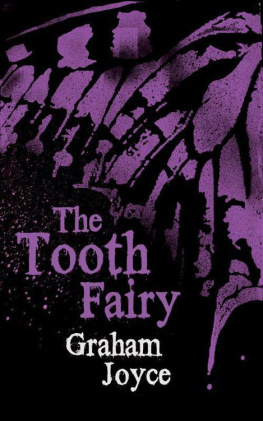Cure Tooth Decay
How to Prevent & Cure Tooth Decay & Cavities Naturally in the Comfort of Your Own Home
Table of Contents
Copyright
Copyright 2015 by Fiona Hathaway - All rights reserved.
This document is geared towards providing exact and reliable information in regards to the topic and issue covered. The publication is sold with the idea that the publisher is not required to render accounting, officially permitted, or otherwise, qualified services. If advice is necessary, legal or professional, a practiced individual in the profession should be ordered.
- From a Declaration of Principles which was accepted and approved equally by a Committee of the American Bar Association and a Committee of Publishers and Associations.
In no way is it legal to reproduce, duplicate, or transmit any part of this document in either electronic means or in printed format. Recording of this publication is strictly prohibited and any storage of this document is not allowed unless with written permission from the publisher. All rights reserved.
The information provided herein is stated to be truthful and consistent, in that any liability, in terms of inattention or otherwise, by any usage or abuse of any policies, processes, or directions contained within is the solitary and utter responsibility of the recipient reader. Under no circumstances will any legal responsibility or blame be held against the publisher for any reparation, damages, or monetary loss due to the information herein, either directly or indirectly.
Respective authors own all copyrights not held by the publisher.
The information herein is offered for informational purposes solely, and is universal as so. The presentation of the information is without contract or any type of guarantee assurance.
The trademarks that are used are without any consent, and the publication of the trademark is without permission or backing by the trademark owner. All trademarks and brands within this book are for clarifying purposes only and are the owned by the owners themselves, not affiliated with this document.
Introduction
Confidence, there is no better way of showing confidence than by standing upright with good posture and having a white, toothy grin plastered upon the face. It is a combination of both mental conditioning and pride in the physical form. However, it is hard to smile when the teeth are infested with cavities.
Around 90% of the overall population has dental cavities, and the statistics only worsen with age. It has been found that 28% of children 5 years old and below have cavities and that a greater portion (about 87%) of the adult population, namely those aged 20 to 39, suffer from this. However, saying that tooth decay comes with aging is erroneous. Poor nutrition and lack of the essential vitamins and minerals that contribute to dental health are among the major reasons behind the drastic increase in figures of tooth decay cases. The condition of the teeth gives away many secrets of an individuals lifestyle and it is therefore important to take care of them.
This eBook will address such concerns by discussing the anatomy of the tooth, followed by a detailed explanation of the causes of cavities. This is imperative in determining how one should deal with these carries. Also, this eBook will talk about proper tooth care and some affordable and effective home remedies for cavities.
Read on and discover some surprising facts about the teeth.
Chapter 1: The Anatomy of the Tooth
The teeth are some of the hardest substances in the body. They are mainly used for mastication and they also aid in speech. The average human adult should have 32 permanent teeth in total, with 28 of these erupting at 13 years old and the last 4 (the wisdom teeth) appearing at 18 years of age.
The Layers of a Tooth
The tooth has three distinct layers, namely the enamel, dentin and pulp. Cavities always affect the outermost layer first and slowly dig their way to the inner portion. The more layers that are affected, the greater the damage dealt by the decay.
Enamel
This is the outermost part of the tooth, which serves as a protection for the inner structures. It is made mostly out of a rock hard mineral called Calcium Phosphatase, which contributes to its sturdiness.
Dentin
After the enamel comes the dentin. It produces a tough mineral substance and contains numerous tubes that connect to the pulp.
Pulp
This is located at the center of the tooth. This is softer compared to the other 2 layers and serves as the living quarters of nerves and blood vessels. Damage to this area will cause pain.
The Parts of the Tooth
The tooth, though small, is made up of several parts. Each of which has a distinct function.
Crown
In terms of structure, the crown is the topmost and most visible part of the tooth. The form or shape of this part determines the function of the tooth.
Cementum
This is a connective tissue that fastens the roots of the teeth to the gums and, subsequently, to the jawbone, preventing it from falling off.
Periodontal Ligament
This is a tissue that, like the cementum, aids in keeping the teeth attached to the gums and jawbone.
Gumline
This is the area where the gums and teeth meet. There is a small groove formed at this area so, without proper brushing technique, plaque or tartar may accumulate and result to various gum and tooth disorders.
Root
This is the bottommost part of the tooth, which comprises about 2/3 of the entire structure. It is implanted into the jawbone.
Different Kinds of Teeth
All humans have a predetermined arrangement and number of teeth regarding its external structure. There are 5 types in total: incisors, canines, molars, premolars, and wisdom teeth.
Incisors
These are located at the front most part of the jaw and are shaped like a chisel. There are 8 in total, with 4 at the top and 4 at the bottom. As the name suggests, these function to cut food.
Canines
Also known as cuspids, these teeth have pointed crowns and serve as the boundary between the premolars and the incisors. There are 4 in total. Because they are sharp, they are used to tear the food the incisors cannot.
Premolars
Premolars are also known as bicuspids because they have two pointed tips (cusps) at the crown. These grow in between the canines and the molars and are mainly used to crush and/or tear food.
Molars
The crowns of these teeth are flat and are used in grinding or chewing food. There are three of these that are lined up at each side of the jaw (upper left, upper right, lower left, lower right), which equates to a total of 12.
3rd Molars a.k.a. Wisdom Teeth
These teeth are the last to erupt, often appearing by the time one turns 18 years old. In most cases, the wisdom teeth have to be taken out as they tend to congest the area where they grow and may impede the growth of the surrounding structures.
Common Non-Congenital Dental Disorders
Poor dental hygiene and inattention to malformations of the structures of the oral cavity could lead to a variety of conditions.
Dental Carries
More commonly known as cavities, these are formed when bacteria accumulate at the enamel. It evades the area and, if not addressed, will dig through the layers of the tooth and may affect adjacent teeth. These are mostly found on the molars and premolars.
Tooth Decay
Most people would erroneously interchange tooth decay with or use it synonymously with cavities. However, unbeknownst to most, tooth decay is a general term which encompasses all diseases of the teeth a category where cavities fall under. If left untreated, it may lead to more serious conditions such as infection, pain and loss of the affected tooth.
Next page






![Ramiel Nagel - Cure Tooth Decay: Remineralize Cavities and Repair Your Teeth Naturally with Good Food [Second Edition]](/uploads/posts/book/53583/thumbs/ramiel-nagel-cure-tooth-decay-remineralize.jpg)

